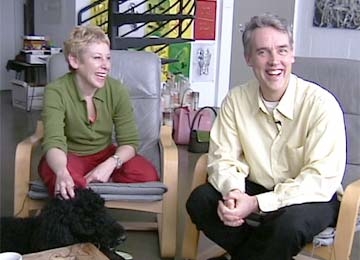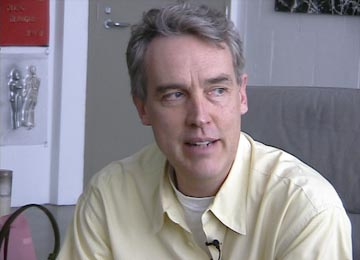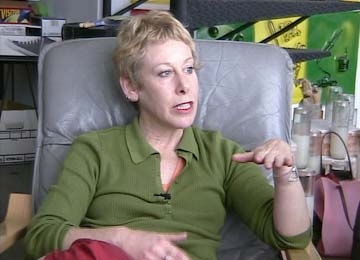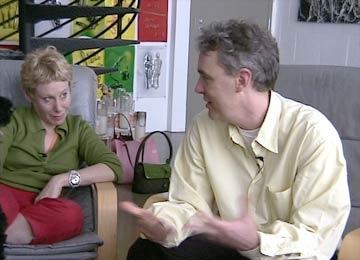Feature: Conversations
Sabina Ott and Mark Johnson
Part I: Painting Now
Painters Mark Johnson and Sabina Ott had not seen each other in the two decades since they graduated from the San Francisco Art Institute as part of the same MFA class. Both went on to dual careers as artists and educators — Johnson is the gallery director at San Francisco State University and Ott recently returned to SFAI as the director of Graduate Studies. When Stretcher invited them to a “Face-Off” reunion they accepted at once. “I liked Sabina from the first moment I met her because the very first thing she said to me was a challenge,” said Johnson. “Challenging, not hostile, right? There’s a fine line,” laughed Ott. Johnson, Ott, Ott’s dog, and the Stretcher crew convened for an amicable discussion where the challenge lay in keeping up with the rich tumble of ideas. The results will appear in two parts. Part I, on art education and the field of painting, follows.
Stretcher What do students need to learn in art school?
Sabina Ott Art school is good training; it’s like a liberal arts education. It teaches you how to think, analyze, and make decisions. Most people in art school don’t go on to be artists; they go on to be doctors and lawyers and accountants and all kinds of things, but they have a mindset that allows them to engage in creative thinking, whatever their field.
Mark Johnson David Salle spoke at the Art Institute around 1990. Kathy Acker was there and they had a memorable dialogue — David almost cried. In the course of the exchange, he said, “I want to remind people that art is at essence an elitist activity, and we need to strengthen its elitism.” I realized that that’s not why I’m interested in education. I’m interested in opening doors outside of the elitist trajectory that art sometimes has. The San Francisco Museum of Modern Art may have 5,000 visitors a day now. It’s exciting that art has achieved a kind of pop success.
SO It’s a destination mall.
MJ It’s a date and it’s hot…
SO Probably more people than the roller rink. But I want to get back to David Salle’s comment — I understand where his statement came from. The impulse to apologize for art not being understandable is a bad one. I can’t expect to speak Spanish if I don’t take a Spanish class. Art is not intuitive. I have to learn something. It’s an acquired taste, like blue cheese, and that’s fine. It’s not Velveeta.
MJ It is an acquired language. I’ve noticed in twenty-five years of teaching that the appreciation for the language of painting is not as widespread as it was. There are more people interested in visual art in general, but the time that painting takes both to make and appreciate may be a little out of style now. New media is a more immediate hit and seems to be more of the moment.
SO Maybe it’s a regional thing. I think San Francisco has never quite decided whether it’s part of East Coast artistic history or European artistic history. Whereas in Los Angeles, it is as if you had no history, so it is more vital because there’s no burden of history. L.A. painting is all over the place. A lot of it doesn’t embody the kind of painterly eye that you’re talking about. L.A. painting is very flat, very pop, and very fast. Painting, like an animal, has to evolve to survive. That’s how it competes in a world of very quick images. I think painting as an activity has been well served by being devalued, placed on a level with the rest of the arts. It has more mobility and has infected other art forms. Videos are made to look like paintings; photos are made to look like paintings. But a knowledge of painting is necessary to make the work. That’s interesting, because it’s a philosophical attitude rather than an activity or a particular object. I’ll settle for that.
Stretcher Do art students need to learn to paint? Or is it enough for them to learn about painting through art history?
MJ The same thing that was always important is still important, which is to be creative. There are a million different histories to draw from. Because I’m at a state school with a large Asian population, we’ve put a lot of time into researching Asian artists in California. Turns out the most famous artist from California, hands down, is Chang Dai Chien. He lived here for twenty years, and he’s as famous in China as Picasso is in the West. But because his idiom was traditional Chinese painting, I didn’t know about him until relatively recently. I’m interested in those kind of things — how history works, what we think of as common information, what’s hidden and why. But my interest in different issues of Asian culture doesn’t necessarily inform my own work. I like to encourage creativity and a sense of freedom of making and play.
SO The intellectual arguments about whether students should learn to paint or not are irrelevant in the classroom because people will insist on learning. If you walk around undergraduate schools, people love to learn craft. Kids — they love it. In their minds, that’s why they’re in school. So they’re painting away. You know, there’s six people trying to paint the figure — usually horribly, and they’re working through it. And then there’s twelve people trying to make an abstract expressionism in some form their own. It’s the same in photography or in film or anything. Kids want to learn how to manipulate things. The same paintings that were being made at school thirty years ago are being made now. People want to learn how to do this stuff. They’ll complain if they don’t learn glazing. Graduate school is different because by that time, supposedly, they’ve learned the skills and they’re trying to integrate their academic learning with their artwork. I think students need one-quarter philosophy, one-quarter cultural studies, one-quarter skills, and one-quarter art history. That’s my formula. But that’s for graduate school. Undergraduates need a good, well-rounded education in all kinds of things and also a real skill and material base, because they have to own the world they’re in. You can’t make anything if you don’t feel like you have control over the physical world. It’s like learning to write.
MJ I’ve been thinking that painting is related to ceramics. Paint is gooey and physical, there’s a surface and there’s the material. And like ceramics, it’s become kind of a funny craft practice. It used to be more connected with philosophy, but right now it doesn’t seem to be as closely linked to philosophical inquiry as other media. Painting used to be primary in the art world because it was the media that most intellectuals worked with. That’s no longer the case. I do think that one of the most interesting things about painting, philosophically, is its relationship to time. Any art practice takes a lot of time. One needs to be fully immersed in it to speak fluently; otherwise there’s an awkwardness, speaking haltingly.
Stretcher What painting do you see now that excites you?
MJ One of the most interesting painters to me in San Francisco is Li Hua-Yi. He got an MFA from the Academy of Art College and could be described as a postmodern classical Chinese ink painter. At first you might see his works as geometric abstractions, but then you look again and see intricate, meditative landscape paintings. I find it interesting that someone like that has zero visibility in San Francisco, whereas as he is very well known in Shanghai and shows in New York.
SO It sounds great. I tend to hate other people’s paintings on principle. It makes me go work. In this area, I like Kara Maria’s work. Not the handkerchief paintings, but the pop star bomb paintings. They’re bold and they’re good. She’s really cranky as a painter, she’s very critical of what she sees and so she’s fun to talk to as a coworker in the field. But I tend to feel critical of other people’s paintings. Especially if they’re showing where I want to show. I saw Alfred Jensen’s work at DIA, a well-curated, tight show of his brightest green and orange paintings — they’re amazing. It seemed very fresh to me in terms of work with systems. I like Matthew Ritchie and people like that who are not necessarily painters. I think of him as an artist who makes things with paintings, although he’s trained as a maker of flat images. I’m interested in work that crosses over categories. I also have a tremendous weakness for my students’ work.
Stretcher What is the role of theory in your teaching?
SO It’s hard to take messy experiences and figure out how they operate as experiences and signs in the world. Since you come from the particular perspective of your life, your experiences of things like gender or race may mean that you intuitively go to things that are uncomfortable for the rest of culture. Afterwards you look at it and maybe understand what you did. Then the task is to exaggerate it or understand it in a broader context than personal experience and taste. That’s part of teaching, too. What you want to teach is the methodology of growing work, interpreting it, interacting with it, and understanding it.
Stretcher Sometimes it seems that students try to squeeze the experience out of theory.
SO That makes terrible artwork, but it’s a product of the larger education system, where we separate mind and body so greatly. It’s a larger issue than art and theory — it’s the way we’re taught to interpret our lives through schools.
MJ The exciting thing about the art world today as opposed to 25 years ago is that people can work from a place of theory and try different things and see what feels best for them. There can be wonderful work that comes from theory, if summoned. People can work from a place of body understanding. Or people can work from rich emotional places. Things are more open than they used to be. As teachers, we just want to keep opening more doors and turning on more lights and walking into more empty rooms, seeing where people choose to follow.
SO There’s a particular impulse in our culture to live within binary opposites. It’s hard to align with that impulse now that we have digital technologies like the Internet, because they are not based on binary opposites. It may be “0101,” but it’s “01”; it’s not one versus one or negative one and one; it’s a continuum, a multiplicity. We’re moving towards understanding intellectually that we can’t go on living in a binary system. I think this change is really broad, really big, and we’re eking our way towards it. Spinoza talked about in the 1500s, a series of planes of immanence. No one teaches Spinoza anymore, at least in the philosophy departments of universities. But his ideas have been popularized by Deleuze, who, along with Guittard, directly references and almost rephrases Spinoza. They write about multiplicities, series of experiences, not separating the intellectual from the arts and the theory, this from that, but life as a series of emotions and events. That reflects reality, but how does one show that to people who have been schooled all their lives to think that things are either-or? It comes alive in teaching people to trust their pre-schooling instincts. It’s a hard thing to teach because people are very afraid of being stupid. They’re taught to be afraid. The first thing is making the classroom a place where people feel safe, where they don’t have to be afraid.
Stretcher I think one learns a lot from the way that the teacher is in the world. How teachers treat you, how they operate, may be even more basic than the words they say, in terms of what people actually learn.
SO There’s a quality of respecting the person you’re talking to and being present in the moment when you’re talking to them. So many students are used to being talked down to. I try to talk with students with the understanding that they’re artists. The conversation is important, what they’re saying is important. There can be resistance to that, too, to acknowledging the weight and seriousness of what they’re trying to accomplish.
MJ Sabina has just talked about two issues that I think are important for teaching. One is trust and the other is challenge. In an environment that is safe but not challenging, we don’t move toward our potential.
Click here for part II of the Johnson-Ott dialogue, on surviving as an artist >>




